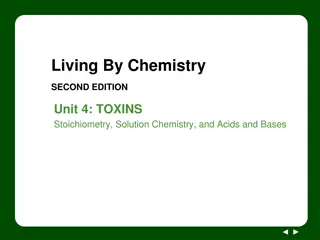Nonanthropogenic Arsenic Standards for the Yellowstone River
Establishing nonanthropogenic arsenic standards along the Yellowstone River to safeguard human health involves considerations of seasonal variations, regulatory statutes, and risk reduction strategies. Dr. Michael Suplee of the Montana Department of Environmental Quality presents data and reasoning on developing effective standards to protect water users.
Download Presentation

Please find below an Image/Link to download the presentation.
The content on the website is provided AS IS for your information and personal use only. It may not be sold, licensed, or shared on other websites without obtaining consent from the author. Download presentation by click this link. If you encounter any issues during the download, it is possible that the publisher has removed the file from their server.
E N D
Presentation Transcript
Establishing Nonanthropogenic Arsenic Standards for the Yellowstone River that Best Protect Human Health MICHAEL SUPLEE, PH.D. WATER QUALITY STANDARDS & MODELING SECTION MONTANA DEPARTMENT OF ENVIRONMENTAL QUALITY JANUARY 10, 2020 WATER POLLUTION CONTROL ADVISORY COUNCIL MEETING
Segment 1: MT/WY Border to Mill Creek (@ Corwin Springs) 45 40 Background Arsenic Conc. ( g/L) 35 30 25 20 15 10 5 Seasonal Standard Daily Nonanthropogenic 0 1 2 3 4 5 6 7 8 9 10 11 12 Month DEQ developed nonanthropogenic arsenic criteria for parts of the Yellowstone River High Flow Season Arsenic Standard1 ( g/L) Low Flow Season Arsenic Standard1 ( g/L) Segment Description DEQ emphasized that at these concentration ranges the drinking water beneficial use is the use most likely to be effected. 11 32 1 MT/WY Border to Mill Creek 11 24 2 Mill Creek to Boulder River 10 18 3 Boulder River to Stillwater River Concerns from industry resulted in WPCAC tabling the rulemaking (until 1/10/2020) 10 14 4 Stillwater River to Clarks Fork Yellowstone Since then, additional analyses have been completed which modify DEQ s recommendations as to how the standards should be expressed n/a (DEQ-7 applies) 10 5 Clarks Fork Yellowstone to Bighorn River 1High Flow season for the Yellowstone River is May July, and the Low Flow season is August - April.
State Statutes Involved 75-5-222 (1): For parameters for which the standards are more stringent than the nonanthropogenic condition, the standard is the nonanthropogenic condition. 75-5-301(2): The board shall formulate and adopt WQ standards, giving consideration to the economics of waste treatment and prevention. 75-5-101: The state s public policy is to conserve water by protecting, maintaining, and improving the quality and potability of water for public water supplies, wildlife, fish
An Objective Way to Assess the Best Expression of the Standards Line of Reasoning: If adopting nonanthropogenic arsenic standards in a particular way while conforming with the statutes can demonstrably decrease cancer risk for people using the Yellowstone River as a water supply, then that is the best expression of the standards.
Since the November 2019 WPCAC Meeting Explored effects on the drinking water beneficial use when nonanthropogenic standards are expressed in different ways High Flow and Low Flow Seasonal Median Standards (2 values); vs. Single Annual Median Standard (1 value). Question: Which nonanthropogenic standards (2 Seasonal, or 1 Annual) result in lower cancer risk to people drinking water from the Yellowstone River downstream from permitted arsenic discharges? Must assume or demonstrate that arsenic in finished drinking water varies with river arsenic concentrations
LOADEST Modeled Arsenic vs. Arsenic in Billings Finished Drinking Water (2009-2017). River and drinking water data matched by day. Arsenic in Billings finished drinking water varies with river arsenic concentration 11.0 10.0 Arsenic in Finished Drinking Water ( g/L) Maximum Concentration Limit 9.0 Billings: PWS No. MT0000153 8.0 7.0 6.0 5.0 4.0 3.0 y = 9.1193ln(x) - 16.45 R = 0.7106 2.0 1.0 0.0 5.0 6.0 Yellowstone River Arsenic ( g/L) (LOADEST Model, At Billings gage 06214500) 7.0 8.0 9.0 10.0 11.0 12.0 13.0 14.0 15.0 16.0 Similar findings elsewhere: Wilson et al., 2002. Arsenic removal in water treatment facilities: Survey of geochemical factors and pilot plant experiments. Illinois Waste Management & Research Center.
Other Principles and Assumptions Human cancer risk from a carcinogen like arsenic is continuous from origin (no safe lower conc.) Maximum Contaminant Level Goal (MCLG) = zero Arsenic is category A (known human carcinogen) EPA Health Advisory, 2018 8.00E-03 7.00E-03 Cancer risk computed using accepted EPA equations and risk factors, and assumptions adopted in DEQ-7: 6.00E-03 Cancer Risk 5.00E-03 4.00E-03 3.00E-03 Cancer Risk Computations Input Variables 2.00E-03 1.00E-03 Current 1.75 44 80 70 2.4 0.0220 0.00E+00 0 10 20 30 40 50 60 70 80 90 100 Cancer Potency Factor (q1*) BCF Body weight (kg) Lifetime exposure (yrs) Water consumed (L/day) Fish consumed (kg/day) Arsenic Concentration ( g/L) Arsenic vs. cancer risk based on current EPA methods and assumptions In DEQ-7 (MCL: 10 g/L = 7.37 X10-4 risk) (equals <1 excess case in 1000) HH Standard ( g/L) At 10-6 risk: At 10-3 Risk: 0.0136 13.6
Segment 4 1 Annual Median Standard and Median Daily Concentration 30 Methods Arsenic Conc. ( g/L) 25 20 15 10 1. To meet 75-5-222, I asked In each segment, does the annual median ever occur during high flow? 5 1 Annual Median Stnd Daily Nonanthropogenic 0 1 2 3 4 5 6 7 8 9 10 11 12 Month Yes. Each annual median is within its corresponding nonanthropogenic high-flow conc. range Annual medians are within the nonanthropogenic condition Segment 4 example: Annual median = 13.0 g/L, High FlowMAX = 13.7 g/L 2. Computed new concentrations for each expression of the nonanthropogenic standards: A. River + discharge @ two seasonal standards, B. River + discharge @ one annual standard Long-term river flows computed as harmonic means (EPA, 1991) River Discharge Cnew = [(C1V1) + (C2V2)] (V1+V2) 3. Calculated total cancer risk associated with river concentrations resulting from bullet 2
Comparison of Total Cancer Risk Resulting from Different Expressions of the Standard* Summary of Findings Reduction in Risk Provided by the Lower- risk Expression of the Standard Two Seasonal Standards One Annual Standard River Segment More Protective Standard Segment Description One Annual Standard 1 MT/WY Border to Mill Creek 2.04184E-03 2.04167E-03 1.67E-07 One Annual Standard 2 Mill Creek to Boulder River 1.55715E-03 1.55702E-03 1.25E-07 Boulder River to Stillwater River One Annual Standard 3 1.18377E-03 1.18370E-03 6.81E-08 Stillwater River to Clarks Fork of the Yellowstone One Annual Standard 4 9.71936E-04 9.71872E-04 6.39E-08 Equal;future permitting may have effects Clarks Fork of the Yellowstone to Bighorn Rivera 5 6.95312E-04 6.95312E-04 0.00E+00 *Raw river water, no drinking water treatment considered. Drinking water treatment reduces arsenic conc. by ~50% at Billings. Standards were computed as the median of the nonanthropogenic concentration. There are no point sources in this segment. 1 MGD was input to the model to assess the standards. a DEQ proposed DEQ-7 standard for High Flow, nonanthropogenic standard for Low Flow.
120.0 13000 Daily Median Total Arsenic ( g/L) 12000 110.0 Yellowstone River Arsenic Concentration ( g/L) Annual Median Standard ( g/L) 11000 100.0 Flow Dillution Factor (unitless) 10000 90.0 Why do the Annual Standards Better Reduce Cancer Risk? Flow Dillution Factor (unitless) 9000 80.0 8000 70.0 7000 60.0 6000 50.0 5000 40.0 Low Flow Stnd ( g/L) 4000 30.0 3000 20.0 2000 10.0 1000 0.0 0 Day of Year EXAMPLE: SEGMENT 1 (MT/WY BORDER TO MILL CREEK) Greater dilution when it matters most
Segment 1: MT/WY Border to Mill Creek (@ Corwin Springs) 45 In Segment 1, cancer risk from the nonanthropogenic standards goes down incrementally as the standards are set to longer and longer timescales (monthly to seasonal, seasonal to annual) 40 Arsenic Conc. ( g/L) 35 30 25 Risk 20 15 10 Monthly Standards: 2.03525 X 10-3 5 Daily Nonanthropogenic Monthly Standards 0 1 2 3 4 5 6 7 8 9 10 11 12 Month 45 40 Arsenic Conc. ( g/L) 35 30 25 20 In Segment 4, the pattern is not as consistent across the timescales, but the annual standard still has the lowest cancer risk. 15 10 2 Seasonal Standards: 2.03511 X 10-3 5 Seasonal Standard Daily Nonanthropogenic 0 1 2 3 4 5 6 7 8 9 10 11 12 Month 45 40 35 Arsenic Conc. ( g/L) 30 25 20 15 10 5 1 Annual Standard: 2.03494 X 10-3 One annual standard Daily Nonanthropogenic 0 1 2 3 4 5 6 7 8 9 10 11 12 Month
Other Findings Permitted discharge volumes would have to be far in excess of the Yellowstone River s highest flows to change the conclusions Indicates that this approach must be very carefully evaluated where effluent dominated waterbodies are concerned
Conclusions Increases and decreases in the Yellowstone River s arsenic concentrations are reflected in drinking water supplies that use the river Therefore: an annual nonanthropogenic median is the better expression of the nonanthropogenic standard compared to two seasonal median standards Reduces cancer risk in segments 1-4 Cancer risk reductions are small, on the order of 1/10,000,000 to 1/100,000,000 Risk in segment 5 is the same via either approach Risk in segment 5 is apparently the same under DEQ-7
Conclusions Adopting the standards as annual nonanthropogenic medians meets the key statutes (Montana Code Annotated): Per 75-5-222(1): All annual medians are of lower concentration than the corresponding max nonanthropogenic high-flow values This means the annual medians are always within the nonanthropogenic condition Per 75-5-301(2): Annual median standards are apparently more economical Per 75-5-101: Annual median standards improve the quality and potability of water for public water supplies
Future Monitoring and Assessment of Yellowstone River Arsenic Wilson Interval was recommended for the two seasonal standards Wilson Interval can also be used to evaluate annual median standards Proportional sampling of Low Flow (75%) and High Flow (25%) periods To detect <25% change in river s median arsenic, with <10% false positives: N=16 samples per segment, collected over 1 year Zero exceedance=full compliance One exceedance= non compliance
Recommended Standards OTHER ASPECTS OF THE NON- ANTHROPOGENIC STANDARDS: River Segment Annual Nonanthropogenic Arsenic Standard ( g/L) Yellowstone River Segment Description No use changes along the Yellowstone River are proposed 28 1 MT/WY Border to Mill Creek Standards apply end-of-pipe; no mixing zones 22 2 Mill Creek to Boulder River For permits, an average monthly limit and a maximum daily limit will be calculated per EPA (1991) methods; no sample shall exceed does not apply 16 3 Boulder River to Stillwater River 13 4 Stillwater River to Clarks Fork of the Yellowstone n/a* 5 Clarks Fork of the Yellowstone to Bighorn River Long-term ambient assessment will evaluate changes in river s median arsenic concentration *In this segment the nonanthropogenic condition is not less that the standard so DEQ-7 standard would continue to apply.
Discussion, Next Steps























